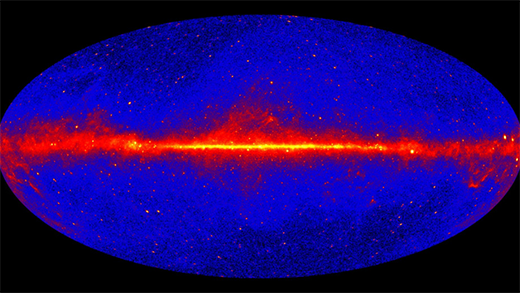| Sep 16, 2021 |
Burning space mystery solved as researchers confirm origins of 'empty sky' gamma-rays
|
|
(Nanowerk News) Star-forming galaxies are responsible for creating gamma-rays that until now had not been associated with a known origin, researchers from The Australian National University (ANU) have confirmed (Nature, "The diffuse γ-ray background is dominated by star-forming galaxies").
|
|
Lead author Dr Matt Roth, from the ANU Research School of Astronomy and Astrophysics, said until now it has been unclear what created gamma-rays – one of the most energetic forms of light in the Universe – that appear in patches of seemingly ‘empty sky’.
|
|
The discovery could offer clues to help astronomers solve other mysteries of the Universe, such as what kind of particles make up Dark Matter – one of the holy grails of astrophysics.
|
 |
| A detailed look at the gamma-ray sky. (Image: NASA/DOE/Fermi LAT Collaboration) (click on image to enlarge)
|
|
“It’s a significant milestone to finally discover the origins of this gamma-ray emission, solving a mystery of the Universe astronomers have been trying to decipher since the 1960s,” Dr Roth said.
|
|
“There are two obvious sources that produce large amounts of gamma-rays seen in the Universe. One when gas falls into the supermassive black holes which are found at the centres of all galaxies – called an active galactic nucleus (AGN) – and the other associated with star formation in the disks of galaxies.
|
|
“We modelled the gamma-ray emission from all the galaxies in the Universe and compared our results with the predictions for other sources and found that it is star-forming galaxies that produce the majority of this diffuse gamma-ray radiation and not the AGN process.”
|
|
ANU researchers were able to pinpoint what created these mysterious gamma-rays after obtaining a better understanding of how cosmic rays – particles that travel at speeds very close to the speed of light – move through the gas between the stars. Cosmic rays are important because they create large amounts of gamma-ray emission in star-forming galaxies when they collide with the interstellar gas.
|
|
Data from NASA’s Hubble Space Telescope and Fermi Gamma-Ray Space Telescope was a key resource used to uncover the unknown origins of the gamma-rays. Researchers analysed information about many galaxies such as their star-formation rates, total masses, physical size and distances from Earth.
|
|
“Our model can also be used to make predictions for radio emission – the electromagnetic radiation that has a frequency similar to a car radio – from star-forming galaxies, which could help researchers understand more about the internal structure of galaxies,” Dr Roth said.
|
|
“We are currently looking at producing maps of the gamma-ray sky that can be used to inform upcoming gamma-ray observations from next-generation telescopes. This includes the Cherenkov Telescope Array, which Australia is involved in.
|
|
“This new technology will hopefully allow us to observe many more star-forming galaxies in gamma-rays than we can detect with current gamma-ray telescopes.”
|

